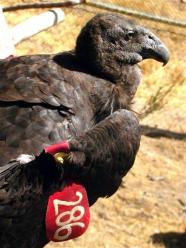|

Endangered California Condors Still Facing Human Threats During the week of January 21, condor #286 (all California condors are assigned a studbook number), a nearly seven-year-old male, went from being high in the pecking order of the Central Coast condor flock to getting pushed around by much younger, less dominant birds. When 286 went from making courtship displays to female condors to getting beat up by adolescent birds, wildlife biologists from Pinnacles National Monument and Ventana Wildlife Society knew something wasn’t right. A sudden shift in behavior by 286 was an indication the bird may have health problems. “We had been trying to capture him since late January because of signs of weakness and poor health,” said Ventana Wildlife Society biologist Joe Burnett. Upon capture on March 4, biologists noted the condor was wobbly on his feet. Testing revealed a high lead level in his blood, indicating potentially fatal lead exposure. Condor biologists immediately transferred the bird to the Los Angeles Zoo for lead poisoning treatment. While at the L.A. Zoo, 286 was radiographed and the shotgun pellets were discovered. Once lead treatment has been completed, Zoo veterinarians plan to extract the pellets to determine the type of ammunition. “We are extremely grateful the bird is still alive, but dismayed this innocent condor was both lead poisoned and gunshot,” said Kelly Sorenson, Executive Director of the Ventana Wildlife Society. “Whoever shot the condor should not be seen as a representative of the hunting community. No self-respecting hunter would do this,” said Jerry Marquez, a central California hunter. “The average hunter is conservation minded and wants to preserve the resource for future generations, not destroy it. Shooting the condor was an act of pure stupidity.” The act of harming an endangered species is also a federal felony. Condor 286’s injuries and resulting removal from the wild were a significant setback in achieving the goal of establishing breeding pairs of condors in the wild. Reproduction of wild offspring is a necessary step toward removing condors from the Endangered Species List. “We were anticipating a breeding attempt by condor 286 this year, so this unfortunate event is a real setback to the flock,” said Sorenson. While unrelated to the shotgun pellets, condor 286’s lead exposure may have occurred from ingestion of lead bullet fragments found in animal carcasses or gut piles. Condors are scavengers, only eating dead animals. In July 2008, California changed hunting regulations to require hunters in the condor’s range to use only non-lead ammunition. Information on the new regulations can be found on the California Department of Fish and Game’s website at: http://www.dfg.ca.gov/wildlife/hunting/condor. Condor biologists see ranching and big game hunting as critical to the survival of the endangered birds. “Open space with an occasional dead large mammal is the kind of landscape condors live in,” said Daniel George, Condor Program Manager at Pinnacles National Monument. “Ranchers and hunters that use non-lead ammunition play a key role in maintaining a healthy landscape for condors and other wildlife.” “The plight of condor 286 illustrates the California condor’s continued struggle for survival,” said Jesse Grantham, California Condor Recovery Program Coordinator for the U.S. Fish and Wildlife Service. “We need to continue to focus on sources of lead in the environment and eliminate that threat to both humans and wildlife.” The U.S. Fish and Wildlife Service (USFWS) is the lead federal partner in the multi-agency California Condor Recovery Program. Release programs are located in Central and Southern California, Baja, Mexico, and Arizona. Currently, California is home to two separate California condor flocks. The Central Coast flock, located around Big Sur and Pinnacles National Monument, and the Southern California flock, located in and around the Los Padres National Forest, north of Los Angeles and east of Ventura. Information about the U.S. Fish and Wildlife’s Endangered Species program may be found at: www.fws.gov/endangered. |
Last updated: February 28, 2015
